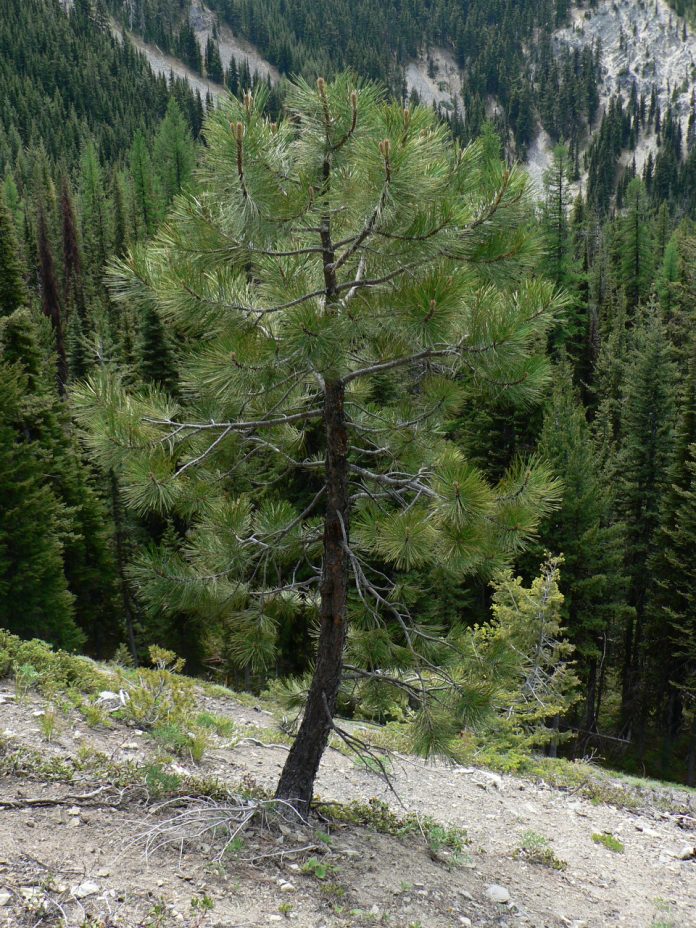The following pines are all native to North America. And with a little bit of care, all have been successfully grown on the prairies. All prefer full sun, a lighter, well trained soil, and a more protected location.
Limber pine (Pinus flexilis) is an alpine/subalpine species, often found in exposed areas in the foothills of the Rockies. Both the species name, flexilis, and the common name, limber pine, refer to the supple young branches that can be tied in knots. It was discovered by Edwin Jones, an American army doctor who accompanied an 1820 expedition to the Rocky Mountains.
Dense and pyramidal when young, it becomes rather broad and flat-topped with age (like many of us) developing a large and uneven crown. Single or multiple trunked, both the trunk and the branches appear thick in proportion to their length. The bark is a soft grey-green, later turning greyish-brown to black.
The needles, in bundles of five, are a dark blue-green, stiff and slightly curved, with three or four lines of stomata on each surface. They persist for 5 or 6 years, lending the tree is very dense appearance. The cylindrical and resinous cones are erect when young, becoming pendulous, hanging at right angles to the stem, once they mature. The edible seeds can be eaten raw, roasted or ground into flour. Although slow growing, limber pines can live for over a hundred years.
They prefer a light soil but are quite adaptable as long as it is reasonably well drained. They’ll grow in sun or partial shade, are drought-tolerant once established, and have no problems other than the occasional sapsuckers who seem to find them attractive. Limber pines are well used as specimens, accents or within a mixed border.
Ponderosa pine (Pinus ponderosa var. scopulorum) is native to South Dakota’s Black Hills, eastern Wyoming and the Rocky Mountains’ eastern foothills. Ponderosa means heavy, a reference to the wood, while scopulorum means of cliffs or rocks, describing its native habitat. It’s smaller and hardier that the species (P. ponderosa) and better adapted to the prairies. Broadly pyramidal (15 x 6 m / 50 x 20 ft.), its bark is dark grey, nearly black. The needles are very sharp and in bundles of three. The brown cones are round, and each scale has a tiny bristle. Obtain trees from seed collected from its northern-most range.
White pine (Pinus strobus), native to much of central and eastern North America, including Manitoba’s southeastern corner, is probably the softest and most sensuous pine available to prairie gardeners. The species name, strobus, refers to its cones.
A valuable softwood lumber tree, during the colonial era white pine was reserved by law for the exclusive use of the Royal Navy for ship masts. Today, it makes a handsome specimen tree. Place it were it can be touched!
But be aware of provenance, the extent of a plant’s native range! Plants grown from seed that originate in the most northern and western portion of its natural range are more likely to be hardy on the prairies than those from further east or south. My own white pine came as a seedling, dug by a friend from the ditch on the highway west of Thunder Bay. It has grown and prospered for four decades, whereas two earlier attempts with commercially available white pines of unknown seed origin had failed.
White pines are graceful, pyramidal trees (15 x 7 m / 50 x 23 ft.) with thin gray bark that becomes brown and furrowed with age. The long, soft pliable blue-green needles are in bundles of five, point forward to the tips of the branches, and generally remain on the tree for two years. The curved cones are long and cylindrical, an attractive lilac-purple, exude a white resin and are retained for two years.
Fast growing, especially when young, white pines live for well over a century. Place them where they’re sheltered from wind as they are vulnerable to winter browning, more so in their early years. Somewhat adaptable, they do well on fertile, moist, well-drained soil in full sun or partial shade.
Although white pine blister rust and white pine weevils are serious concerns where large populations of white pines exist, neither has been very problematic on the prairies where these pines are relatively uncommon.
Retired from the University of Saskatchewan, Sara’s most recent book is Growing Fruit in Northern Gardens with Bob Bors. She’s been hosting garden tours for over 20 years – to Great Britain, Ireland, Europe, Turkey and Iceland. Join her for a tour to France this September [Contact Ruth at 1-888-778-2378, www.worldwideecotours.com]
This column is provided courtesy of the Saskatchewan Perennial Society (SPS; saskperennial@hotmail.com ). Check our website (www.saskperennial.ca) or Facebook page (www.facebook.com/saskperennial) for a list of upcoming gardening events. The Spring Plant Exchange will be held on Sunday, May 29. The plant exchange will start around two o’clock for more information please see the website. These are “member only” events, but memberships are available at the door for $10.00.


